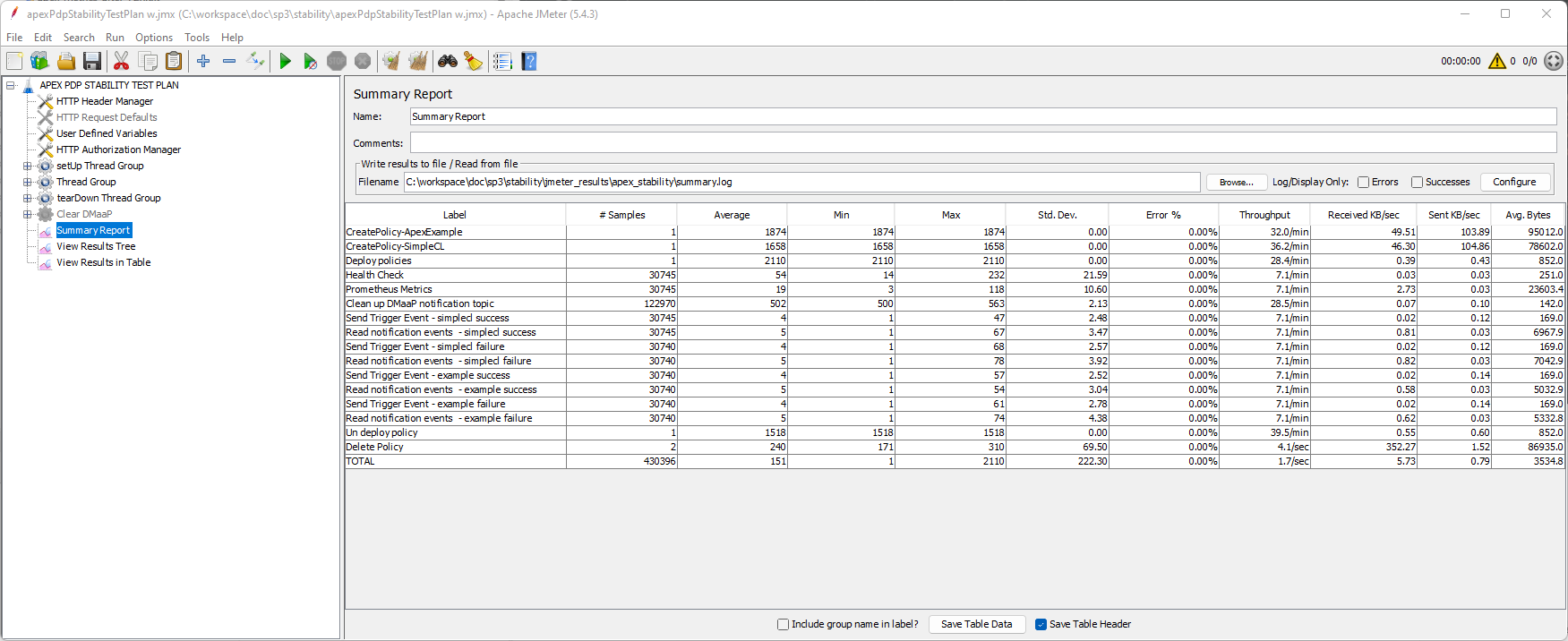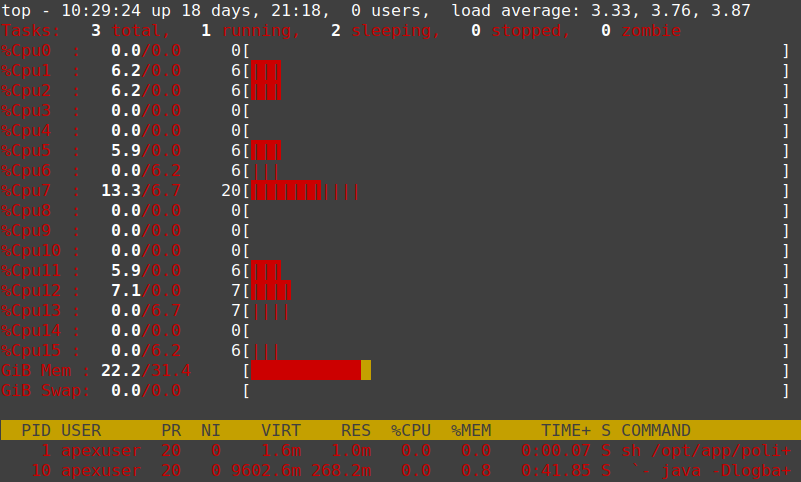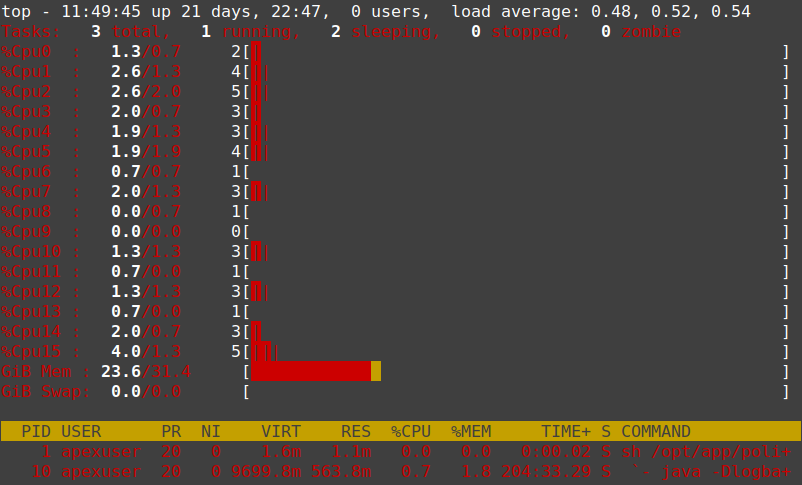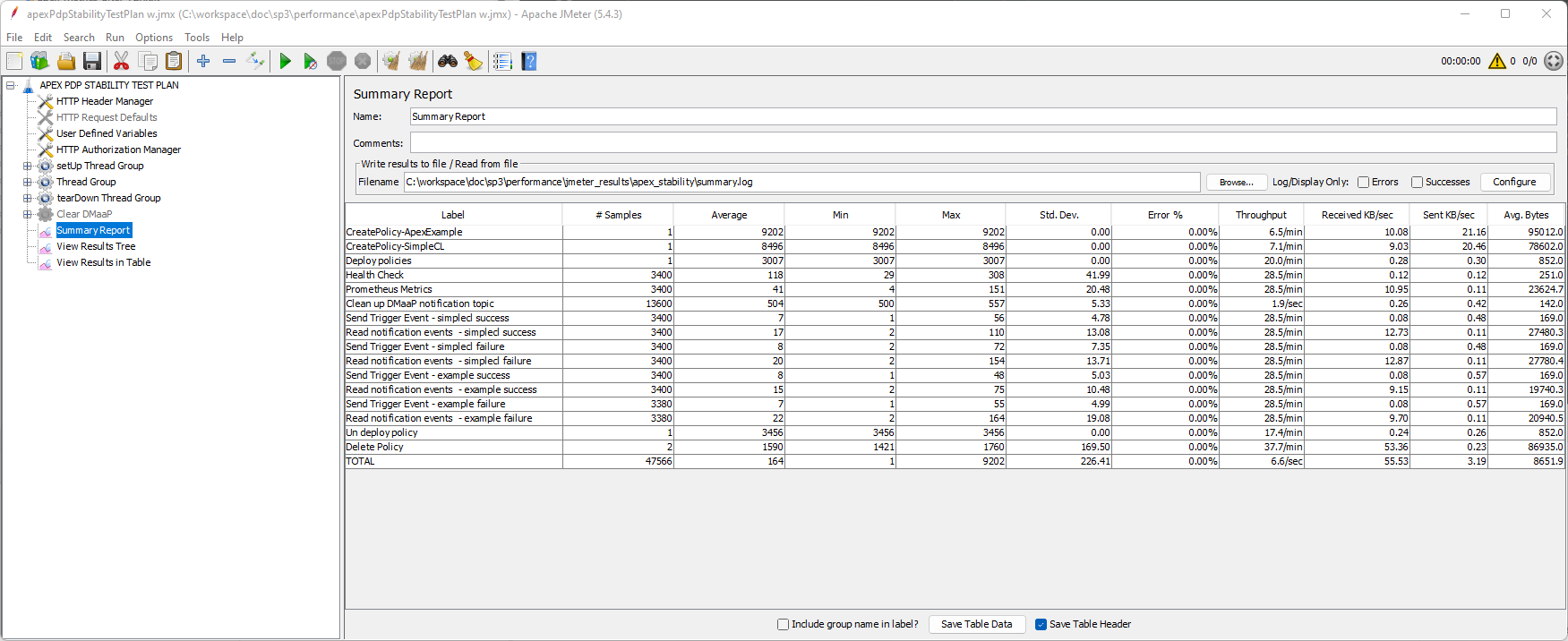Policy APEX PDP component
Both the Stability and the Performance tests were executed in a full ONAP OOM deployment in Nordix lab.
Setup Details
Deploying ONAP using OOM
APEX-PDP along with all policy components are deployed as part of a full ONAP OOM deployment. At a minimum, the following ONAP components are needed: policy, mariadb-galera, aai, cassandra, aaf, and dmaap.
Before deploying, the values.yaml files are changed to use NodePort instead of ClusterIP for policy-api, policy-pap, and policy-apex-pdp, so that they are accessible from jmeter:
policy-apex-pdp NodePort 10.43.131.43 <none> 6969:31739/TCP
policy-api NodePort 10.43.67.153 <none> 6969:30430/TCP
policy-pap NodePort 10.43.200.57 <none> 6969:30585/TCP
The node ports (31739, 30430 and 30585 above) are used in JMeter. The HOSTNAMEs for JMeter are set to the IPs returned by running “kubectl get node -o wide” and to find the applications for each node by running “kubectl describe node <node-name>”.
Set up policy-models-simulator
- Policy-models-simulator is deployed to use CDS and DMaaP simulators during policy execution.
- Simulator configurations used are available in apex-pdp repository:
testsuites/apex-pdp-stability/src/main/resources/simulatorConfig/
It is run as a docker image from a node accessible to the kubernetes cluster:
docker run -d --rm --publish 6680:6680 --publish 31054:3905 \
--volume "apex-pdp/testsuites/apex-pdp-stability/src/main/resources/simulatorConfig:/opt/app/policy/simulators/etc/mounted" \
nexus3.onap.org:10001/onap/policy-models-simulator:2.7-SNAPSHOT-latest
The published ports 6680 and 31054 are used in JMeter for CDS and DMaaP simulators.
Creation of VNF & PNF in AAI
In order for APEX-PDP engine to fetch the resource details from AAI during runtime execution, we need to create dummy VNF & PNF entities in AAI. In a real control loop flow, the entities in AAI will be either created during orchestration phase or provisioned in AAI separately.
Download & execute the steps in postman collection for creating the entities along with it’s dependencies. The steps needs to be performed sequentially one after another. And no input is required from user.
Create VNF & PNF in AAI for Apex S3P
Make sure to skip the delete VNF & PNF steps.
JMeter Tests
Two APEX policies are executed in the APEX-PDP engine, and are triggered by multiple threads during the tests. Both tests were run via jMeter.
- Stability test script is available in apex-pdp repository:
testsuites/apex-pdp-stability/src/main/resources/apexPdpStabilityTestPlan.jmx
- Performance test script is available in apex-pdp repository:
testsuites/performance/performance-benchmark-test/src/main/resources/apexPdpPerformanceTestPlan.jmx
Note
Policy executions are validated in a stricter fashion during the tests. There are test cases where up to 80 events are expected on the DMaaP topic. DMaaP simulator is used to keep it simple and avoid any message pickup timing related issues.
Stability Test of APEX-PDP
Test Plan
The 72 hours stability test ran the following steps.
Setup Phase
Policies are created and deployed to APEX-PDP during this phase. Only one thread is in action and this step is done only once.
- Create Policy onap.policies.apex.Simplecontrolloop - creates the first APEX policy using policy/api component.
This is a sample policy used for PNF testing.
- Create Policy onap.policies.apex.Example - creates the second APEX policy using policy/api component.
This is a sample policy used for VNF testing.
Deploy Policies - Deploy both the policies created to APEX-PDP using policy/pap component
Main Phase
Once the policies are created and deployed to APEX-PDP by the setup thread, five threads execute the below tests for 72 hours.
Healthcheck - checks the health status of APEX-PDP
Prometheus Metrics - checks that APEX-PDP is exposing prometheus metrics
- Test Simplecontrolloop policy success case - Send a trigger event to unauthenticated.DCAE_CL_OUTPUT DMaaP topic.
If the policy execution is successful, 3 different notification events are sent to APEX-CL-MGT topic by each one of the 5 threads. So, it is checked if 15 notification messages are received in total on APEX-CL-MGT topic with the relevant messages.
- Test Simplecontrolloop policy failure case - Send a trigger event with invalid pnfName to unauthenticated.DCAE_CL_OUTPUT DMaaP topic.
The policy execution is expected to fail due to AAI failure response. 2 notification events are expected on APEX-CL-MGT topic by a thread in this case. It is checked if 10 notification messages are received in total on APEX-CL-MGT topic with the relevant messages.
- Test Example policy success case - Send a trigger event to unauthenticated.DCAE_POLICY_EXAMPLE_OUTPUT DMaaP topic.
If the policy execution is successful, 4 different notification events are sent to APEX-CL-MGT topic by each one of the 5 threads. So, it is checked if 20 notification messages are received in total on APEX-CL-MGT topic with the relevant messages.
- Test Example policy failure case - Send a trigger event with invalid vnfName to unauthenticated.DCAE_POLICY_EXAMPLE_OUTPUT DMaaP topic.
The policy execution is expected to fail due to AAI failure response. 2 notification events are expected on APEX-CL-MGT topic by a thread in this case. So, it is checked if 10 notification messages are received in total on APEX-CL-MGT topic with the relevant messages.
Clean up DMaaP notification topic - DMaaP notification topic which is APEX-CL-MGT is cleaned up after each test to make sure that one failure doesn’t lead to cascading errors.
Teardown Phase
Policies are undeployed from APEX-PDP and deleted during this phase. Only one thread is in action and this step is done only once after the Main phase is complete.
Undeploy Policies - Undeploy both the policies from APEX-PDP using policy/pap component
Delete Policy onap.policies.apex.Simplecontrolloop - delete the first APEX policy using policy/api component.
Delete Policy onap.policies.apex.Example - delete the second APEX policy also using policy/api component.
Test Configuration
The following steps can be used to configure the parameters of test plan.
HTTP Authorization Manager - used to store user/password authentication details.
HTTP Header Manager - used to store headers which will be used for making HTTP requests.
User Defined Variables - used to store following user defined parameters.
Name |
Description |
|---|---|
HOSTNAME |
IP Address or host name to access the components |
PAP_PORT |
Port number of PAP for making REST API calls such as deploy/undeploy of policy |
API_PORT |
Port number of API for making REST API calls such as create/delete of policy |
APEX_PORT |
Port number of APEX for making REST API calls such as healthcheck/metrics |
SIM_HOST |
IP Address or hostname running policy-models-simulator |
DMAAP_PORT |
Port number of DMaaP simulator for making REST API calls such as reading notification events |
CDS_PORT |
Port number of CDS simulator |
wait |
Wait time if required after a request (in milliseconds) |
threads |
Number of threads to run test cases in parallel |
threadsTimeOutInMs |
Synchronization timer for threads running in parallel (in milliseconds) |
Run Test
The test was run in the background via “nohup”, to prevent it from being interrupted:
nohup ./apache-jmeter-5.4.3/bin/jmeter.sh -n -t apexPdpStabilityTestPlan.jmx -l stabilityTestResults.jtl
Test Results
Summary
Stability test plan was triggered for 72 hours. There were no failures during the 72 hours test.
Test Statistics
Total # of requests |
Success % |
Error % |
Average time taken per request |
|---|---|---|---|
430397 |
100 % |
0.00 % |
151.694 ms |
Note
There were no failures during the 72 hours test.
JMeter Screenshot

Memory and CPU usage
The memory and CPU usage can be monitored by running “top” command in the APEX-PDP pod. A snapshot is taken before and after test execution to monitor the changes in resource utilization. Prometheus metrics is also collected before and after the test execution.
Memory and CPU usage before test execution:

Prometheus metrics before 72h test
Memory and CPU usage after test execution:

Performance Test of APEX-PDP
Introduction
Performance test of APEX-PDP is done similar to the stability test, but in a more extreme manner using higher thread count.
Setup Details
The performance test is performed on a similar setup as Stability test.
Test Plan
Performance test plan is the same as the stability test plan above except for the few differences listed below.
Increase the number of threads used in the Main Phase from 5 to 20.
Reduce the test time to 2 hours.
Run Test
nohup ./apache-jmeter-5.4.3/bin/jmeter.sh -n -t apexPdpPerformanceTestPlan.jmx -l perftestresults.jtl
Test Results
Test results are shown as below.
Test Statistics
Total # of requests |
Success % |
Error % |
Average time taken per request |
|---|---|---|---|
47567 |
100 % |
0.00 % |
163.841 ms |
JMeter Screenshot

Summary
Multiple policies were executed in a multi-threaded fashion for both stability and performance tests. Both tests ran smoothly without any issues.